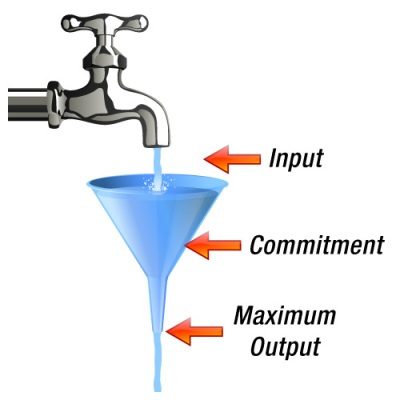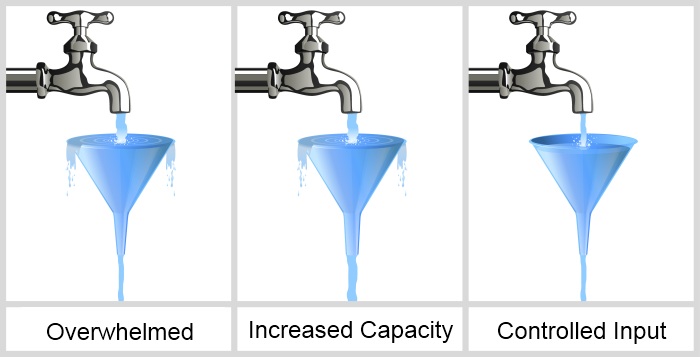Controlled input: the missing piece of time management
In this post, I’ll talk about a problem that affected me personally really badly and that I see in too many other fellow entrepreneurs & developers.
Twelve years ago I thought that increasing my productivity would solve my problems. It did the exact opposite. My problems did not disappear. They became bigger as I became more highly productive. Until I learnt that I was missing an obvious piece of perfect time management: commitment or what I prefer to call: controlled input. For those who don’t see the obvious coming (like me a few years ago), this is for you.
In 2000, I started freelancing as I was hit by the entrepreneurial fever. Very quickly I became overwhelmed by work and projects. Sometimes, I had to completely stop moving and think “what is it you are doing?” I was doing 3 things at the same time, in addition to reacting to every external disturbance such as phone calls. That’s when I decided to invest in something I hadn’t been taught at school or by my parents: organizing myself. At the time, delegating was out of my reach.
I purchased top rated books on the subject and went to training courses. I started to learn and to put everything into practice. Productivity increased dramatically. I became an unstoppable working machine. In the less than 2 years that followed this, I was able to create 5 companies (with the satisfaction that all still exist today) in addition to freelancing and working on the numerous side projects I had. This was made possible with increased productivity and the fact that almost 95% of my conscious time was spent working. I started to earn a lot of money, more than I could handle. But all of this had a price: I became like a zombie and eventually, I burnt out.
I had missed something very important that I hadn’t learnt how to manage yet: my commitments. I was tempted to say yes to everyone, and more importantly, to myself. As an example, any new idea I had would be turned into a new company, immediately. I finally learnt how to solve that problem the hard way.
When I talk about it to friends, employees or students, I use the illustration of the tap and the funnel. The tasks coming in flow from the tap, your input, while the bottleneck of the funnel is you, your maximum output, your productivity. What’s in the funnel is your commitment.
Below is an illustration of three possible scenarios.
- Overwhelmed: you have too much work and you can’t face it. The fact you are overwhelmed affects your productivity negatively because of stress and other technical factors, eg having to multi task. Not to count the waste of unfinished tasks (or low quality).
- Increased Capacity: you decide to learn GTD to increase your productivity. It works, you have a larger bottleneck, but you are still overwhelmed. You do more with the same time. By your new behavior, you teach others (and yourself) that you can do even more. Instead of solving your problem, this actually worsens it.
- Controlled Input: you control both external solicitations and personal commitments. Input is controlled and matches your capacity. Everything is under control. This is a part of self-awareness.
Properly or improperly managing your commitments has many other effects, for example – trust. The more commitment you fail to meet, the more you teach others (by conditioning) that you are not reliable. They will progressively lose trust. Everything you say will be seen as something said by the unreliable guy. It works both sides: if you succeed in meeting almost every commitment you make, you will teach others that you are very reliable. You will build trust and increase your circle of influence. This includes trust in yourself.
Here are few ideas on how to manage input:
- Deadlines set by others: in the developer’s world, we often face situations in which other people set deadlines for us. When I face such situation, I re-estimate the task myself and compare it to my actual commitments. If there is a difference, I confront the person who set the deadline. In short, I learn to say no, but with a proper argument. Saying no without any explanation is not only rude, but unprofessional.
- External disturbances: I’m always amazed when I see someone looking at his ringing phone saying: “oh no, not him, he disturbs me all the time“. Why not simply ignore the call? You are NOT committed to answer the phone, you can call him back at a better time. This statement is valid for everything including emails. They can wait another 3 hours to get an answer, right? In addition, these interruptions are real productivity killers (Nass, Ophir, Wagner 2009).
- Ongoing projects: Limit your ongoing projects. Don’t involve yourself in two big projects at the same time. I limit myself to one large project and one or two much smaller ones. In order to do that, I put every idea or thing I would like to do on a list. I update the list often with new stuff, but nothing goes out of it until I have the free room (time) for it.
Increasing your productivity is very easy. The techniques work and are easy to learn. The hard part is learning to say no. To others, but also yourself. If you are like me, it will take some time to be completely healed from this bad behavior. But being aware is certainly one big step. Be productive, control your input, be happy (Oswald, Proto, Sgroi 2009).
You can leave a response, or trackback from your own site.



